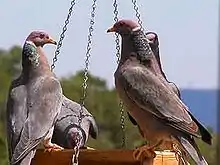| Patagioenas | |
|---|---|
 | |
| Band-tailed pigeons (Patagioenas fasciata) | |
| Scientific classification | |
| Domain: | Eukaryota |
| Kingdom: | Animalia |
| Phylum: | Chordata |
| Class: | Aves |
| Order: | Columbiformes |
| Family: | Columbidae |
| Subfamily: | Columbinae |
| Genus: | Patagioenas Reichenbach, 1853 |
| Type species | |
| Columba leucocephala (white-crowned pigeon ) Linnaeus, 1758 | |
| Species | |
|
17, see text. | |
| Synonyms | |
|
Chloraenas Bonaparte, 1854 (unjustified emendation) | |
Patagioenas is a genus of New World pigeons whose distinctness from the genus Columba was long disputed but ultimately confirmed. It is basal to the Columba-Streptopelia radiation. Their ancestors diverged from that lineage probably over 8 million years ago. While the biogeographic pattern of this group suggests that the ancestors of the typical pigeons and turtle-doves settled the Old World from the Americas, Patagioenas may just as well be the offspring of Old World pigeons which only radiated into different genera later, given that the cuckoo-doves (Macropygia) of Southeast Asia also seem to be closely related.[1]
Taxonomy
The genus Patagioenas was introduced by the German naturalist Ludwig Reichenbach in 1853 with the white-crowned pigeon (Patagioenas leucocephala) as the type species.[2] The genus name combines the Ancient Greek patageō meaning "to clatter" and oinas meaning "pigeon".[3]
There are 17 species of Patagioenas, which can be assigned to 4 groups based on mtDNA cytochrome b, cytochrome c oxidase subunit I, and NADH dehydrogenase subunit 2, as well as the nuclear β-fibrinogen intron 7 data combined with analyses of vocalizations and morphology. They could be considered subgenera, but one of them remains unnamed as such and thus they are only informally listed here:[4]
caribaea/band-tailed group (Chloroenas): Tails with terminal bands and iridescent neck; rows of low single coos. Apparently the most basal group.[1]
- Band-tailed pigeon, Patagioenas fasciata
- Chilean pigeon, Patagioenas araucana
- Ring-tailed pigeon, Patagioenas caribaea
leucocephala group (Patagioenas sensu stricto): Iridescent neck and dark plumage, or white edged outer wing coverts, or scaly appearance; groups of triple coos with the first call in each drawn out except in speciosa
- White-crowned pigeon, Patagioenas leucocephala
- Scaly-naped pigeon, Patagioenas squamosa
- Scaled pigeon, Patagioenas speciosa
- Picazuro pigeon, Patagioenas picazuro
- Bare-eyed pigeon, Patagioenas corensis
- Spot-winged pigeon, Patagioenas maculosa
cayennensis group: No display plumage except iridescent head in cayennensis; groups of double or triple coos with the first call in each short
- Pale-vented pigeon, Patagioenas cayennensis
- Red-billed pigeon, Patagioenas flavirostris
- Maranon pigeon, Patagioenas oenops
- Plain pigeon, Patagioenas inornata
plumbea group (Oenoenas): Small size, plain plumage, rounded tails, small bills, phrase composed of high single coos
- Plumbeous pigeon, Patagioenas plumbea
- Ruddy pigeon, Patagioenas subvinacea
- Short-billed pigeon, Patagioenas nigrirostris
- Dusky pigeon, Patagioenas goodsoni
A fossil species (Curtis pigeon) initially placed in Chloroenas, Patagioenas micula (Early Pliocene of Curtis Ranch, USA) is known. A small member of this genus, it probably indeed belonged to the band-tailed group.
Footnotes
- 1 2 Johnson et al. (2001), Cheke (2005)
- ↑ Reichenbach, Ludwig (1853). Handbuch der speciellen Ornithologie (in German). Leipzig: Friedrich Hofmeister. p. xxv.
- ↑ Jobling, James A. (2010). The Helm Dictionary of Scientific Bird Names. London: Christopher Helm. p. 294. ISBN 978-1-4081-2501-4.
- ↑ Johnson et al. (2001), Mahler & Tubaro (2001)
Sources
- Cheke, Anthony S. (2005). Naming segregates from the Columba–Streptopelia pigeons following DNA studies on phylogeny. Bull. B.O.C. 125(4): 293–295. PDF fulltext
- Johnson, K.P.; De Kort, S; Dinwoodey, K.; Mateman, A.C.; Ten Cate, C.; Lessells, C.M.; Clayton, D.H. (2001). "A molecular phylogeny of the dove genera Streptopelia and Columba" (PDF). Auk. 118 (4): 874–887. doi:10.1642/0004-8038(2001)118[0874:AMPOTD]2.0.CO;2. hdl:20.500.11755/a92515bb-c1c6-4c0e-ae9a-849936c41ca2.
- Mahler, Bettina & Tubaro, Pablo L. (2001). Relationship between song characters and morphology in New World pigeons. Biol. J. Linn. Soc. 74(4): 533–539. doi:10.1006/bijl.2001.0596 (HTML abstract)
Further reading
- Couve, E. & Vidal, C. (2003): Aves de Patagonia, Tierra del Fuego y Península Antártica. Editorial Fantástico Sur Birding Ltda. ISBN 956-8007-03-2